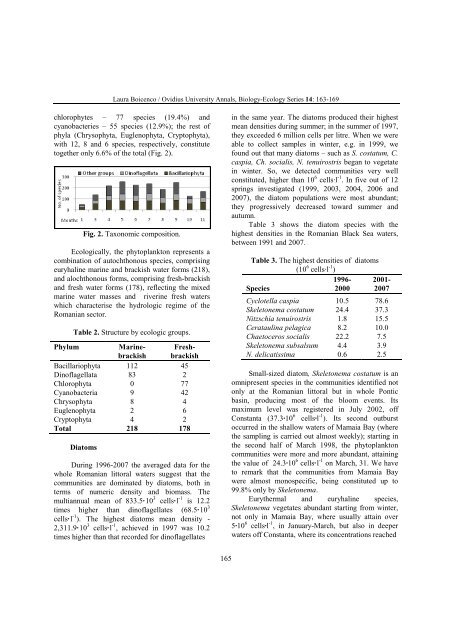VOLUM OMAGIAL - Facultatea de Ştiinţe ale Naturii şi Ştiinţe Agricole
VOLUM OMAGIAL - Facultatea de Ştiinţe ale Naturii şi Ştiinţe Agricole
VOLUM OMAGIAL - Facultatea de Ştiinţe ale Naturii şi Ştiinţe Agricole
You also want an ePaper? Increase the reach of your titles
YUMPU automatically turns print PDFs into web optimized ePapers that Google loves.
Laura Boicenco / Ovidius University Annals, Biology-Ecology Series 14: 163-169<br />
chlorophytes – 77 species (19.4%) and<br />
cyanobacteries – 55 species (12.9%); the rest of<br />
phyla (Chrysophyta, Euglenophyta, Cryptophyta),<br />
with 12, 8 and 6 species, respectively, constitute<br />
together only 6.6% of the total (Fig. 2).<br />
Fig. 2. Taxonomic composition.<br />
Ecologically, the phytoplankton represents a<br />
combination of autochthonous species, comprising<br />
euryhaline marine and brackish water forms (218),<br />
and alochthonous forms, comprising fresh-brackish<br />
and fresh water forms (178), reflecting the mixed<br />
marine water masses and riverine fresh waters<br />
which characterise the hydrologic regime of the<br />
Romanian sector.<br />
Table 2. Structure by ecologic groups.<br />
Phylum MarineFreshbrackish brackish<br />
Bacillariophyta 112 45<br />
Dinoflagellata 83 2<br />
Chlorophyta 0 77<br />
Cyanobacteria 9 42<br />
Chrysophyta 8 4<br />
Euglenophyta 2 6<br />
Cryptophyta 4 2<br />
Total 218 178<br />
Diatoms<br />
During 1996-2007 the averaged data for the<br />
whole Romanian littoral waters suggest that the<br />
communities are dominated by diatoms, both in<br />
terms of numeric <strong>de</strong>nsity and biomass. The<br />
multiannual mean of 833.5·10 3 cells·l -1 is 12.2<br />
times higher than dinoflagellates (68.5·10 3<br />
cells·l -1 ). The highest diatoms mean <strong>de</strong>nsity -<br />
2,311.9·10 3 cells·l -1 , achieved in 1997 was 10.2<br />
times higher than that recor<strong>de</strong>d for dinoflagellates<br />
165<br />
in the same year. The diatoms produced their highest<br />
mean <strong>de</strong>nsities during summer; in the summer of 1997,<br />
they excee<strong>de</strong>d 6 million cells per litre. When we were<br />
able to collect samples in winter, e.g. in 1999, we<br />
found out that many diatoms – such as S. costatum, C.<br />
caspia, Ch. socialis, N. tenuirostris began to vegetate<br />
in winter. So, we <strong>de</strong>tected communities very well<br />
constituted, higher than 10 6 cells∙l -1 . In five out of 12<br />
springs investigated (1999, 2003, 2004, 2006 and<br />
2007), the diatom populations were most abundant;<br />
they progressively <strong>de</strong>creased toward summer and<br />
autumn.<br />
Table 3 shows the diatom species with the<br />
highest <strong>de</strong>nsities in the Romanian Black Sea waters,<br />
between 1991 and 2007.<br />
Table 3. The highest <strong>de</strong>nsities of diatoms<br />
(10 6 cells∙l -1 )<br />
1996- 2001-<br />
Species<br />
2000 2007<br />
Cyclotella caspia 10.5 78.6<br />
Skeletonema costatum 24.4 37.3<br />
Nitzschia tenuirostris 1.8 15.5<br />
Cerataulina pelagica 8.2 10.0<br />
Chaetoceros socialis 22.2 7.5<br />
Skeletonema subsalsum 4.4 3.9<br />
N. <strong>de</strong>licatissima 0.6 2.5<br />
Small-sized diatom, Skeletonema costatum is an<br />
omnipresent species in the communities i<strong>de</strong>ntified not<br />
only at the Romanian littoral but in whole Pontic<br />
basin, producing most of the bloom events. Its<br />
maximum level was registered in July 2002, off<br />
Constanta (37.3∙10 6 cells∙l -1 ). Its second outburst<br />
occurred in the shallow waters of Mamaia Bay (where<br />
the sampling is carried out almost weekly); starting in<br />
the second half of March 1998, the phytoplankton<br />
communities were more and more abundant, attaining<br />
the value of 24.3∙10 6 cells·l -1 on March, 31. We have<br />
to remark that the communities from Mamaia Bay<br />
were almost monospecific, being constituted up to<br />
99.8% only by Skeletonema.<br />
Eurythermal and euryhaline species,<br />
Skeletonema vegetates abundant starting from winter,<br />
not only in Mamaia Bay, where usually attain over<br />
5∙10 6 cells∙l -1 , in January-March, but also in <strong>de</strong>eper<br />
waters off Constanta, where its concentrations reached





